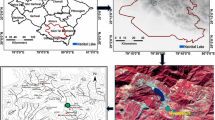Summary
A definitive method of isotope dilution mass spectrometry (IDMS) was developed to determine four different iodine species in aquatic systems (iodide, iodate and two organoiodine compounds: one of the organic species is chromatographically elutable from a column filled with an anion exchanger resin, the other one is not). The iodine species were analysed after the isotope dilution step with an enriched 129I spike and after their chromatographic separation. The total iodine concentration was measured after decomposition of organic compounds in the aquatic system by UV irradiation. Different types of natural water samples (river water, water of a pond, moorland lake water) were analysed and important water parameters like pH-value, redox potential, oxygen content and dissolved organic carbon were measured for each of these samples. The total iodine concentration in the different samples differed only slightly in the range of 2–7 μg/l. In most of the moorland lake water samples only the two organoiodine species could be detected. In these samples the concentration of iodide and iodate was less than the detection limit of 0.5 μg/l and 0.1 μg/l, respectively. On the other hand, all four iodine species could be determined in most of the river water samples. Positive correlations were found for the oxygen content of the water samples and the iodate concentration as well as for the redox potential and the anionic organoiodine compound.
Similar content being viewed by others
References
Bulman RA (1988) In: Bulman RA, Cooper JR (eds) Speciation of fission and activation products in the environment. Elsevier, London New York, p 213
Andreae MO (1986) In: Bernhard M, Brinckman FE, Sadler PJ (eds) The importance of chemical speciation in the environmental processes. Dahlem Workshop Reports, Life Science Research Report 33. Springer, Berlin Heidelberg New York, p 301
Wong G (1980) Mar Chem 9:13
Truesdale V (1978) Mar Chem 6:1
Chapman P (1985) Deep-Sea Res 30:1247
Robens E, Aumann D (1988) J Environ Radioact 7:159
Heumann KG, Seewald H (1985) Fresenius Z Anal Chem 320:493
Heumann KG, Schindlmeier W, Zeininger H, Schmidt M (1985) Fresenius Z Anal Chem 320:457
Heumann KG, Weiß H (1986) Fresenius J Anal Chem 323:852
Behrens H (1985) In: Bulman RA, Cooper JR (eds) Speciation of fission and activation products in the environment. Elsevier, London New York, p 223
Heumann KG, Reifenhäuser C (1990) In: Mattheß G (ed) Progress in hydrogeochemistry. Springer, Berlin Heidelberg New York (in press)
Heumann KG (1988) In: Adams F, Gijbels R, van Grieken R (eds) Inorganic mass spectrometry. Wiley, New York, p 301
Author information
Authors and Affiliations
Additional information
In memoriam of Dr. I. Linus Barnes who died in January, 1990. Dr. Barnes was senior scientist at the National Institute of Standard and Technology in Gaithersburg, USA. He made numerous outstanding contributions to the field of mass spectrometry and IDMS
Rights and permissions
About this article
Cite this article
Reifenhäuser, C., Heumann, K.G. Development of a definitive method for iodine speciation in aquatic systems. Fresenius J Anal Chem 336, 559–563 (1990). https://doi.org/10.1007/BF00331416
Received:
Issue Date:
DOI: https://doi.org/10.1007/BF00331416




